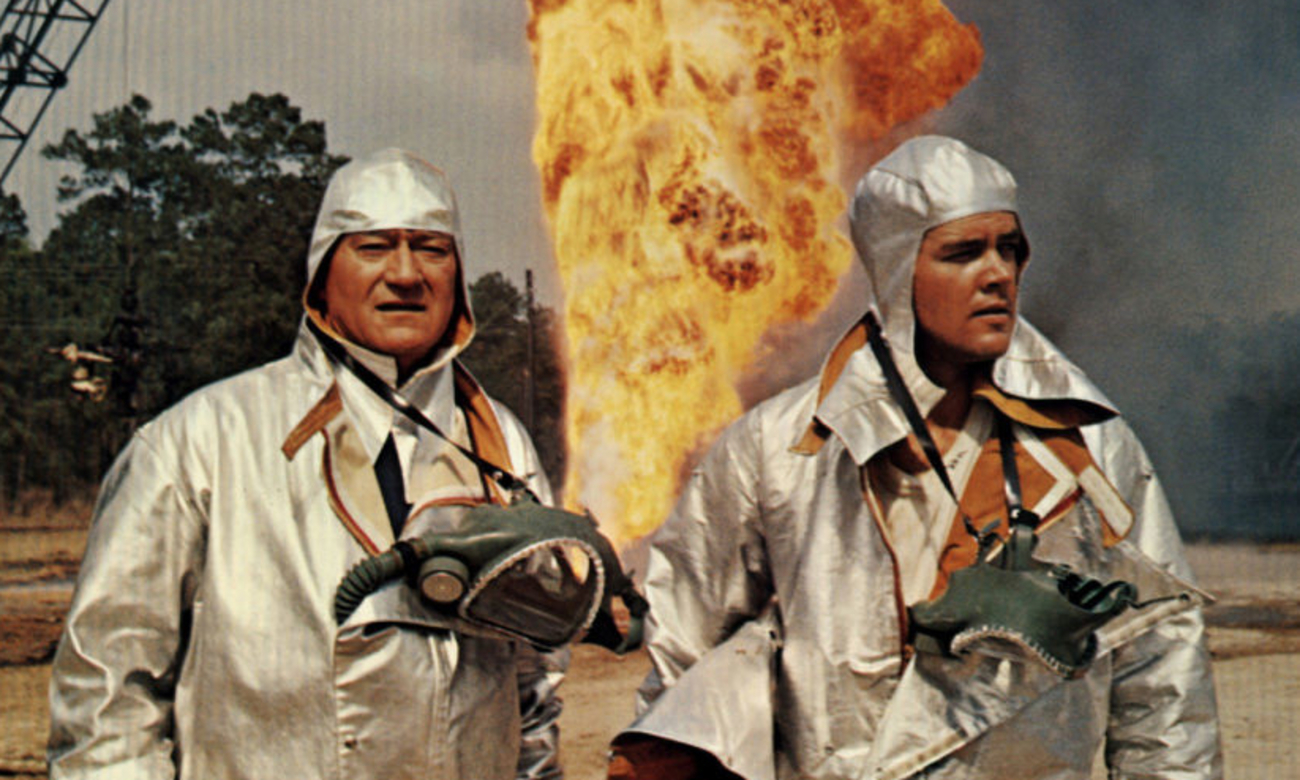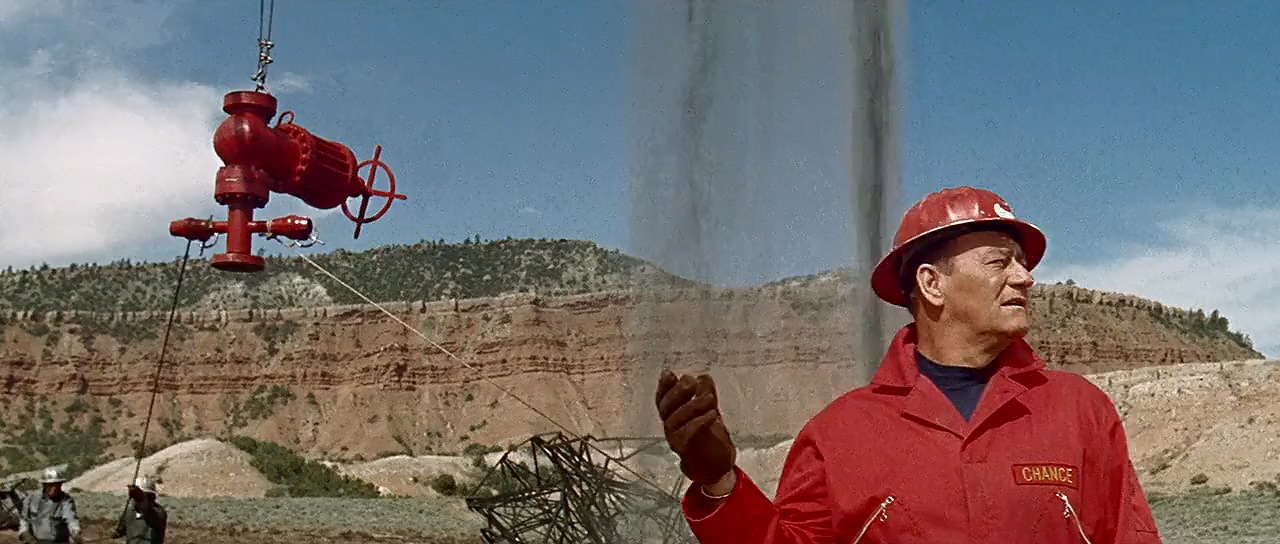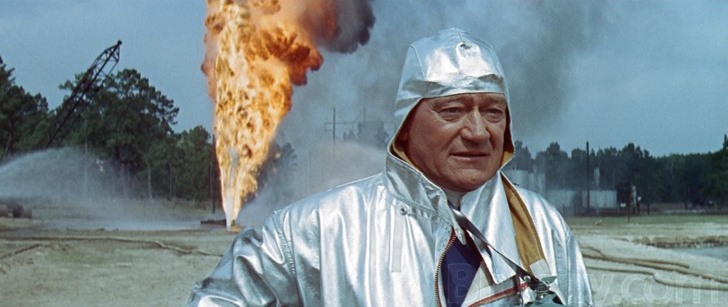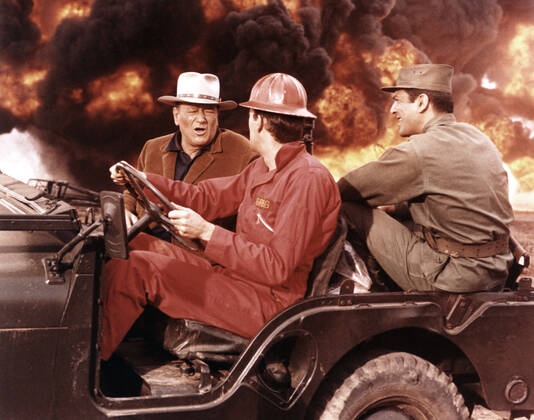Red Adair – Firefighter who extinguished 2000 oilwell fires

Early Life

Paul Neal ‘Red’ Adair was born in the American oil capital of Houston, Texas, in 1915. As soon as he could toddle, he witnessed first-hand the power of fire in the workshop of his blacksmith father, Charles and by the time he was six had witnessed his first oil well fire.
The Adair family was a large, poor one of eight children and so young Red – nicknamed for the color of his hair – left high school early to take on various odd jobs to earn an extra income for the family before joining the Southern Pacific Railroad in 1936. Low wages and no advancement meant that he was itching to move on and in 1938, he joined the oil industry. As he told his wife, with the war coming and the US slowly gearing up to take part (despite the isolationists) he knew the country’s military would need oil in large quantities.
Apart from learning from the ‘bottom up’ the skills of extracting ‘black gold’ from the earth, he also experienced the seeming chaos of fighting relatively small oil well fires. It was here that Red proved an exceptional man. Whilst everyone else was running away as fast as they could, he was invariably the one heading towards the flames.
First Blowout
On his first blowout, he stood two feet away from the flame spout – the sound of pressurized oil and gas was enough to deafen him and escaped into the atmosphere with enough force to tear him into very small pieces. His engineer’s brain analyzed the problem and he began tightening the bolts on the flange that had come loose, “There was no question in my mind that I wouldn’t manage it … fires and blow-outs are battles against formidable adversaries that would never show mercy – quite simply I could only ever lose it once. Surviving my first gave me my first inkling into what I really wanted to do.”
His oilman’s career was abruptly interrupted by other world-shattering events. The US entered World War II after the bombing of Pearl Harbor and, with the US declaration of war in December 1941, Adair joined up and served in the 139th Bomb Disposal Squad, rising to the rank of staff sergeant. His work on diffusing unexploded ordinance proved his extremely cool head under pressure and extreme danger plus his vast knowledge of how to utilize and control explosives safely.
After being demobbed he returned to the oil industry to spend 14 years working as deputy to Myron Kinley who quickly recognized his abilities. Kinley was a pioneering expert in managing oil fires and Adair leaned quickly, demonstrating his characteristic courage and a flair for innovation and improvement of extreme firefighting techniques.

Red Adair’s biographical book “An American Hero”
The start of Adair’s new career path coincided with a period of rapid expansion in the field of global oil and gas drilling. The post-war world was demanding ever-increasing numbers of personal motor vehicles and in order to slake its thirst for cheap petroleum, new fields of gas and oil exploration sprang up around the world. This rapid expansion exponentially increased the potential for well-head fires and blowouts on a global scale and, consequently, made getting to and fighting these fires more and more complicated.
There are few mishaps as spectacular as a large oil well blowout; wild wells spray their surroundings with hundreds of thousands of barrels of crude oil each day they remain unchecked. And when a blowout catches fire, all bets are off. Fuelled by an endless, high-pressure geyser of crude oil and subterranean gases, a well fire creates a towering flare that can reach up to eight hundred feet. Couple this with an average fire temperature of 1600 degrees Celsius (a temperature that, according to eyewitnesses can melt the average fire truck dashboard at 500 feet away) and you have extreme danger to both human life and the wider environment.
Despite the obvious dangers, Adair proved adept at using Kinley’s techniques and, indeed, improving on them with every fire he tackled. ”It scares you: all the noise, the rattling, the shaking,” Adair once said, describing a blowout. ”But the look on everybody’s face when you’re finished and packing, it’s the best smile in the world; there’s nobody hurt, and the well’s under control.”
The first thing to do with an oil fire is to deny the blaze oxygen. You can use water or foam sprayed at the wellhead but the sheer volume of water needed is immense. An easier way is to rapidly remove the air (and consequently the oxygen) from the site of the conflagration. This is where the explosives come in.
When explosives detonate they burn the air around them really quickly – using up all the oxygen in the immediate atmosphere. If you’re lucky, this lack of air at the base of the fire will halt the flames and quench the fire, allowing a new air-tight drill head to be placed over the now inert geyser. Until the wellhead is still volatile – oil vapor fills the air and the merest spark can set the fire raging again. To counter this situation, one of the first major innovations to reduce this was to make all tools from brass – these don’t spark against steel fittings.
A string of high-profile and risky rigs was put out during the period between 1945 and 1959, including in 1957 several large oil fires in Algeria where it wasn’t only the oil that was fired up – the local population was revolting against the Colonial French authorities. The profitable oil fields were a bone of armed contention for both sides! For this fire Adair went back to an old way of extinguishing oil well fires; drilling a second shaft into the main one and flooding the surging oil and gas with water, concrete, and mud to smother the fire – he wasn’t going to make a present of explosives to either side. Quite simply, Kinley and Adair were pretty much the only game in town, and up until the 1970s, they were unparalleled in the world industry.
In 1959 Adair set up on his own. Kinley had finally succumbed to injuries he had received in the 40s whilst Adair was at war. He was severely burned at a fire in Venezuela and shattered his leg at Goliad in Texas which greatly reduced his mobility, and proved to be too slow to attend to the bigger fires safely. Many in the oil business were amazed – they had assumed the larger-than-life Adair had bought Kinley out years ago but Red had wanted to preserve his friend’s dignity and him to wind up his own company on his own terms.
His larger-than-life persona quickly established his celebrity status. Clothing his entire team in red boiler suits, red hats, and helmets they made a splash although, at first, Adair’s company nearly went bust. For the first three months of operation, there were no calls for their expertise, then suddenly the floodgates opened; three small oilfield fires, all in Texas, which saved the company from bankruptcy.
After that, the jobs kept on coming, including oil fires in Iran in the 1960s and an entire Texas gas field.
“Hellfighters” the movie
Along the way Red-met John Wayne and in 1967 they made ‘The Hellfighters’. This too needed Red on hand – not as a technical advisor but as a fireman. Filming a controlled fire early one morning it got out of hand igniting a large part of the set and Adair had to go into action – Wayne astutely rolled the cameras to add another exciting firefighting sequence to the movie (with his close-ups cut in naturally).
From here Red was in demand for everything from talk shows to quiz shows; Wayne planned a second movie but lung cancer took him in 1979. Adair wasn’t idle, however; he’d fought a fire on the EKOFISK Bravo oil platforms in the North Sea in 1977. This fire had resisted all attempts to extinguish it and consequently spilled 8.2 million gallons of crude oil, causing a 20-mile slick that covered 200 miles of the British coastline and killed hundreds of thousands of seabirds. Being in the middle of the ocean presented particular problems that the engineering genius worried about until he came up with a solution. It was something that, apparently, owned part of its inception to the Gerry Anderson puppet show ‘Thunderbirds’.
Based on his longstanding hobby of speed boating and wide experience of firefighting (and inspired by a puppet show about impossible rescues), he began to plan his ocean-going firefighting platform Thanos – featuring massive pumps to provide thousands of gallons of seawater to douse fires a 350-ton crane, diving bells to deliver frogmen to inspect platform foundations and remote-controlled submersibles to place explosives safely and bring back bodies, etc. His platform was able to work 24 hours a day and was soon to be tested in the most tragic conditions.
Piper Alpha
In July 1988 the Piper Alpha oil platform exploded in the stormy North Sea, 120 miles off the coast of Scotland. At the time it was unknown how great the death toll was but, ultimately, 167 bodies were recovered. When the explosion took place the heat shield around the top of the platform was dislodged and had taken both of the crew compartments to the bottom of the sea. Adair assessed that 80 percent of the rig had been destroyed in the explosion and that debris littering the seabed floor would hamper both the recovery of casualties but also the well capping below the stormy ocean. The damage was terrible and eventually – having had to retreat from several dangerous flare-ups – Thanos finally quelled the fire.
Prioritizing Family
The clean-up and Red’s experience of this fire in particular led to him stepping back from the active firefighting aspects of his company and concentrating on innovative technologies to help reduce the risk of it ever happening to anyone again.

In 1991 he responded to a personal plea from President George Bush and was instrumental in speeding the shipment of crucial firefighting supplies and equipment to Kuwait. At 78 he was still fighting fires under the watchful eye of the world’s press and, as noted before, he and his company fought the overwhelming majority of the fires. Once again he was hailed an international hero but he was slowing and although he’d put on a good show for the press, he wanted to spend his remaining time with his family.
Eventually, in 1994 he decided to hang up his red overalls and retire after a life that included something few men could boast: 2000 successfully extinguished oil and gas fires.
In 2004, after 10 years of getting to know a family, he’d largely been absent from, Paul Neal Adair peacefully passed away in a Houston hospital at the age of 89.
Our family was extremely close, small for sure but we were all extremely close. My grandfather took my friends and I fishing, he was at high school functions, walked my down aisle of my wedding. He made sure he was where he needed to be even if he had to fly or drive that extra mile.
S. Adair
Mr. Adair’s grandchild
From an action-adventure movie to discovering the real (no less exciting story), I really think he left the world a safer place for his presence in it and urge you (if you’re interested) to read the authorized biography below – it does miss out on the Kuwaiti oil fires but includes so many fires and dangerous situations than I could include here.








Great article but this paragraph …..
“ In 2004, after 10 years of getting to know a family, he’d largely been absent from…….”
Is extremely disrespectful and inaccurate. Our family was extremely close, small for sure but we were all extremely close. My grandfather took my friends and I fishing, he was at high school functions, walked my down aisle of my wedding. He made sure he was where he needed to be even if he had to fly or drive that extra mile.
Dear S,
We appreciate your feedback and clarification on our recent article. It is an honor for us that you, a family member of Mr. Adair, have read the article and taken the time to comment on it.
We want to reassure you that it was never our intention to be disrespectful towards Mr. Adair in any way. As professionals in the oilfield health and safety industry, we hold Mr. Adair in the highest regard as an icon in our field, respected and known globally.
We understand that working in oilfield HSE often requires being away from loved ones and traveling to remote locations around the world to save lives. It is a difficult but necessary task that we undertake in order to provide for our families and, as Mr. Adair did, make a positive impact on the industry.
With your permission, we would be honored to include your comment in the article to help readers better understand Mr. Adair’s love and care for his family.
Sincerely,
Lucky
I am trying to make contact with Red’s grandchildren. I have nominated Red to be inducted into the US Army Ordnance Corps Hall of Fame. For Red’s service during WWII in Army Bomb Disposal and his support for fighting the oil well fires in Kuwait. His family will be invited to attend the event if he is inducted.
I am trying to make contact with Red’s grandchildren. I have nominated Red to be inducted into the US Army Ordnance Corps Hall of Fame. For Red’s service during WWII in Army Bomb Disposal and his support for fighting the oil well fires in Kuwait. His family will be invited to attend the event if he is inducted.